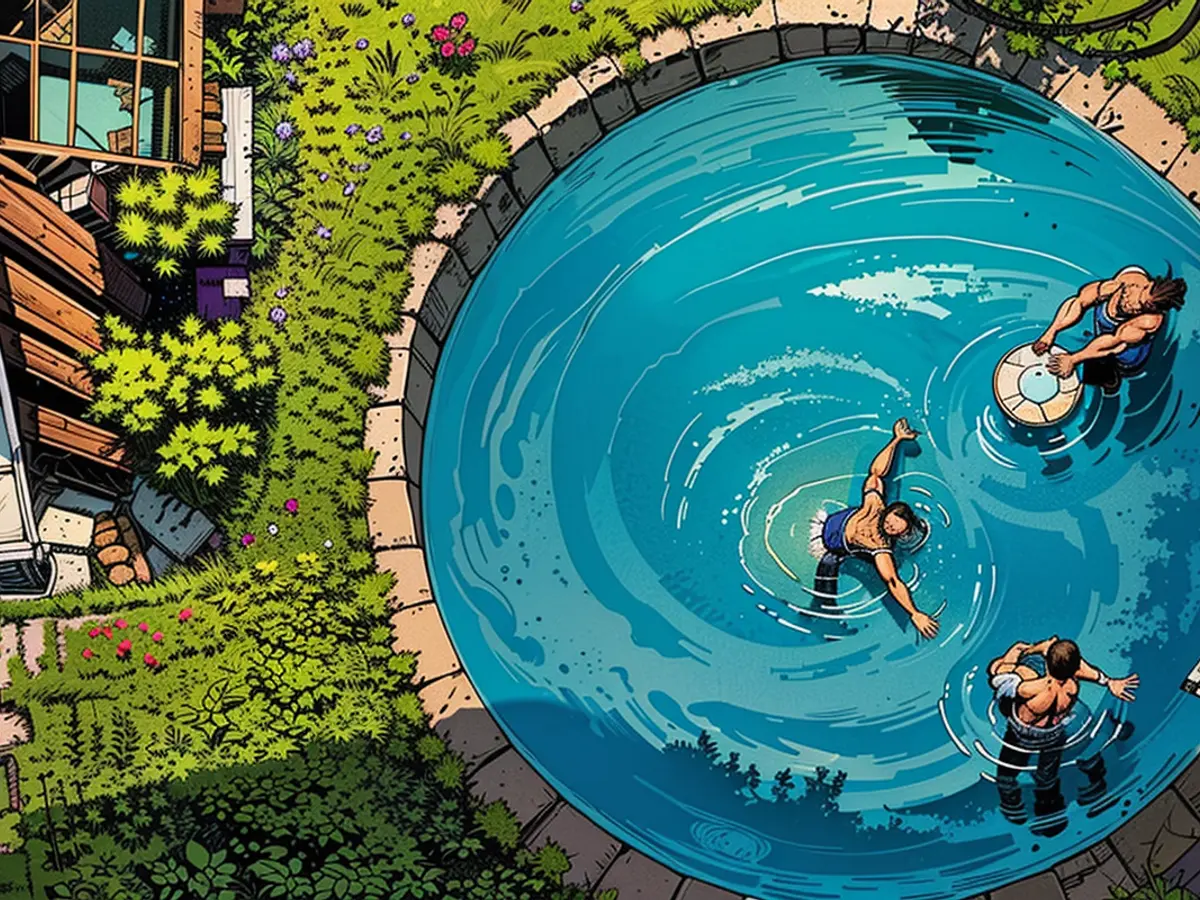A pool for the garden - this is something to consider
Planting a pool in one's own backyard brings vacation feeling into the garden. For swimming enjoyment, one comes even with a small money pouch. However, essential equipment should by no means be spared.
Having a pool in the garden is always better. Hot days become much more bearable. And even the view promises relaxation. The market offers various options. But what should I pay attention to? How should I approach this topic in the first place?
"First and foremost, one should consider what one wants to use the pool for," says Ute Wanschura, managing director of the German Swimming Pool and Wellness Association in Cologne. "Is it simply a refreshing place for the children to play in? Do I need it for therapeutic purposes, such as water gymnastics? Or do I want to swim regularly in it?" This depends on how big and stable the pool needs to be.
Pools come in different types and price ranges. The cheapest options are inflatable or portable pools for the garden. They are stabilized by a bladder or steel walls and are not buried in the ground. Setting them up is relatively simple and can be done yourself.
More expensive are high-quality in-ground pools with prefabricated ready-made pools or concrete pools. Natural, but somewhat labor-intensive are pond pools. They are planted and come without chemicals. One can bathe in them like in a garden pool. "Natural pools are sustainable and ecologically significant," explains Michael Henze from the German Landscape, Sports Field, and Swimming Pool Construction Association in Bad Honnef. These pools are usually built by specialized companies. They are a kind of intermediate solution - half pond, half pool. While the water is clear and filtered, the water treatment is done biologically.
Hygienic Swimming Pleasure - How it Works
A good water treatment should be considered from the start, regardless of the pool type. "Since the pool is not only supposed to be used for one season, it is recommended for beginners to use professional water treatment with a pump and filter system from the start," says Ute Wanschura. This saves water because the dirty content does not have to be poured into the garden every time. The filter and pump should be adjusted to the size of the pool.
And importantly: The pool needs a cover, which prevents coarse contaminants and saves energy by keeping the heat in the water longer and reducing evaporation. It is the A and O for every pool - whether cheap, expensive, or children's paddling pool.
The Perfect Pool Size
For swimming, a pool depth of about 1.35 meters is recommended. With a width of four meters and a length of eight meters, it offers sufficient space. "However, the pool can also be smaller if it is equipped with a counter-current system," says Ute Wanschura.
Caution: The space requirement of a garden pool is greater than many people think and is important for planning. "Many customers decide on a size that is too large and are then surprised by how dominant the pool is on the plot," says Michael Henze. "A medium-sized pool with a width of five meters and a length of seven meters is suitable for most gardens. Smaller plots can accommodate pools with a size of three by five meters."
And then there's the matter of the subsoil: Pools must be stable and level. The subsoil must support the weight of a pool filled with water. "To ensure stability and prevent sinking into the ground, a base plate is usually required. Without a base plate, cracks in the pool construction could occur," says Ute Wanschura.
The location in the garden is important as well, as it significantly affects swimming pleasure. A sunny spot is pleasant. Here, the water is heated by natural energy. The water basin should ideally be wind-protected and not under trees, whose leaves, branches, and needles fall down.
Large above-ground pools and built-in pools should not be placed too close to the neighboring property. "One doesn't want to constantly present oneself on a presentational platform and dance around," says Wanschura - but there are also legal regulations:
"In many building ordinances, a distance of three meters from the neighboring property is prescribed, but not in all," says Michael Henze. It's best to inquire at the garden office or the building authority of the municipality how it is regulated on site. "One can avoid a lot of trouble if one speaks with one's neighbors before the pool is installed."
To ensure the sustainability of your pool, you might consider natural pools, which are planted and free from chemicals. They are constructed by specialized companies and offer a balance between a garden pond and a swimming pool, with clear and filtered water treated biologically.
Investing in a professional water treatment system with a pump and filter from the start can be beneficial. It saves water by not requiring the emptying of dirty contents into the garden and ensures a clean swimming environment.
Building a pool in your garden requires careful planning, considering its size, stability, and location. A medium-sized pool with a width of five meters and a length of seven meters often suits most gardens, but the space requirement can be surprisingly larger than anticipated.
The subsoil, which supports the weight of the filled pool, should be considered. A base plate is often necessary to maintain stability and prevent cracks in the pool construction. The location of the pool, ideally in a sunny, wind-protected area, also impacts swimming pleasure.
In many building ordinances, a distance of three meters from the neighboring property is required, but it's best to check with the local building authority or garden office to confirm the regulations in your area to avoid any potential disputes with neighbors.







